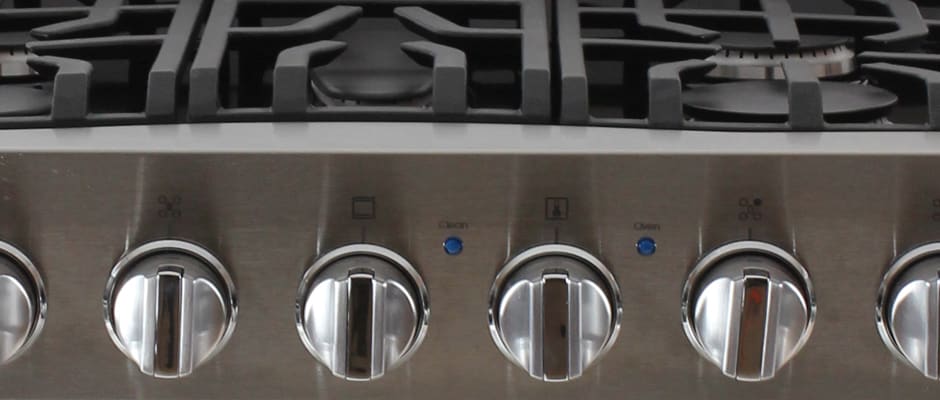Introduction
With the new, streamlined D3 series, Viking is hoping to expand the appeal of their appliances. At $3,600, the dual-fuel D3 range isn't cheap, but it's still half the price of a Viking Professional (read: semi-pro; you will not find a 30" range in a restaurant) and will still make the neighbors jealous.
Design & Usability
{{section_header}}{{section.name}}{{/section_header}}
Viking's D3 is a little more accessible.
Viking hasn't thrown out much of their old pro range designs for the D3, as it still retains much of that aggressive, boxy look the brand popularized. But this range doesn't quite look like it came straight out of a Michelin-starred kitchen. A few subtle elements make this range take the edge off Viking's traditional, industrial look.
Unlike the other higher-end ranges that adhere to the older utilitarian designs, the D3 has implemented a decorative glass surround (gasp), something that you don't see in a typical pro range with its submarine-style windows. The grates hold another touch of this new aesthetic, with softened curves. And, it should be noted, you can get the D3 in an array of custom trim colors.
Like any pro range devoid of LCDs, timers, and other gadgets, the Viking D3 is a fairly simple machine to use since it hardly has any controls. The front knobs might make this a bit more of a temptation for toddlers, but that's a danger common to every gas range. The self-cleaning oven is divided by three easily removable rolling racks.
{{photo_gallery "Front Image", "Controls", "Drawer Photo", "Vanity", "Burners", "Upper", "Lower", "Range", "Oven Controls"}}
Features
This Viking D3 is a dual fuel model with a gas rangetop and electric oven, a configuration many people prefer since it supposably takes the best of both worlds. The gas rangetop features two power burners, two lower-power burners in the back, and a center fish burner for added coverage under the continuous grates. Below, the electric oven holds three rolling racks and has a heated convection fan to the back, and a ten-pass electric broiling element on the top. This is a lot to cram into a 4.1 cubic foot cavity, so we're not sure if it can handle a 28-pound turkey.
Conclusion
{{section_header}}{{section.name}}{{/section_header}}
Remember that price equals performance, brand, and aesthetics. Not just performance.
There is a fallacy poisoning the world of appliances: that price equals performance. Clearly a line divides the mediocre products—afflicted by cost-cutting measures—from the well made and reasonably priced. And yes, many high-end appliances outperform their entry-level competitors at the margins. But unless you've got a Michelin star, the line separating the well-made from luxury isn't usually one of performance, just as no one argues that a Lamborghini will do a better job than a Honda Accord on a daily commute.
But for some owners, it's all about design. Sure Vikings are favored by serious chefs across America, but you can also find untouched and unused in many fancy houses, opposite a dinner table adorned with takeout. But that doesn't mean it's silly or irresponsible to own one. A range takes up a significant space and is visible in three dimensions, you'd be remiss if you didn't consider aesthetics and design. Just make sure your honest with yourself about why you're buying it so you make the best choice you can.
Oven, Broiler, & Convection
Science Introduction
{{section_header}}{{section.name}}{{/section_header}}
To review the {{product.name}}, we ran it through our thorough testing procedure, gathering data to analyze its oven, rangetop, and broiler. Though we've given our own analysis, this section allows people to examine the data for themselves.
Oven Performance
{{section_header}}{{section.name}}{{/section_header}}
The Viking's oven is expensive for a reason.
Unlike most ovens, the D3's thermostat doesn't subtract 25°F for convection, something users should make sure to remember. But what the oven lacks in crazy convection options and features, it makes up with an impressive performance set to 350°F, which is the equivalent of being set to 375°F in a conventional oven. In our test, the oven averaged 370°F and stayed between 359°F and 381°F. This gets our attention.
The keep-warm temperature did run cooler than the 200°F it claimed it would, but 183°F is a far more civilized temperature for keeping food warm. If someone wants dried-out food, they'll get raisins. Unfortunately, the dial's maximum temperature was far below the industry standard of 550°F at 550°F, and in practice it was even lower, averaging a temperate 475°F, though it was very consistent. If you cook frequently with temperatures over 500°F, this is not the oven for your kitchen.
{{photo_gallery "Primary Oven", "Secondary Oven", "Oven Temperature"}}
Rangetop Performance
{{section_header}}{{section.name}}{{/section_header}}
The D3 takes care of part of the typical simmering problem.
The D3's front two burners (18,000 and 17,000 BTU/hr) carried 48 oz of water to a quick boil, taking 4.5 and 5.5 minutes respectively. In the rear, the low power burner took 14 minutes and the workhorse right burner took nine. While you could boil water with the oval center burner, it's not worth the wait.
Most gas ranges have difficulty simmering small quantities, since a burner's minimum temperature is bound by the gas's minimum combustion temperature. For this rangetop, all but one of the burners exhibited the typical simmering problems with minimum temperatures of 176°F (front right), 270°F (rear left: the low-powered burner!), and 218°F (rear right). Only the high-powered front right burner could satisfy our simmer, hitting a very impressive 74°F. So whereas other gas ranges are all mediocre, three-quarters of this viking is abysmal and one-quarter is one of the best we've ever seen.
{{photo_gallery "Range-top"}}
Other Tests
{{section_header}}{{section.name}}{{/section_header}}
The exceptional broiler deserves a shout-out, since it burned to 600°F in less than four-and-a-half minutes. If you cook with the Maillard reaction but don't like going outside, this range gets it done.
{{photo_gallery "Other"}}
Meet the tester
Ethan writes reviews and articles about science for Reviewed.com, and edits the Science Blog. He's originally from Vermont and thinks the bicycle and guitar are examples of perfected technology. Prior to Reviewed.com, he studied furiously at Middlebury College.
Checking our work.
Our team is here for one purpose: to help you buy the best stuff and love what you own. Our writers, editors, and lab technicians obsess over the products we cover to make sure you're confident and satisfied. Have a different opinion about something we recommend? Email us and we'll compare notes.
Shoot us an email


